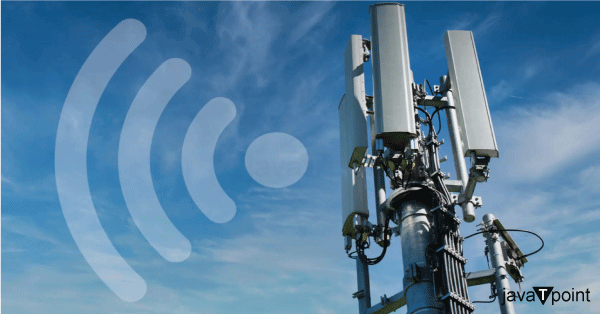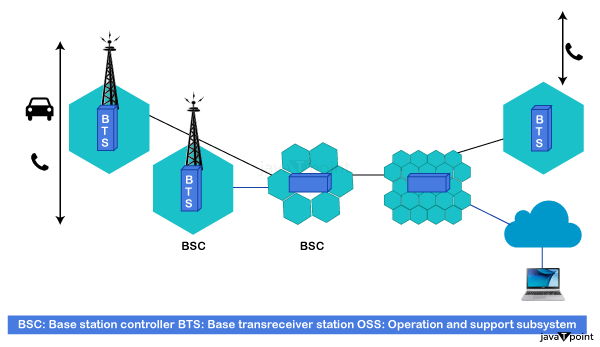Cellular Network
A cellular network is a system of radio waves dispersed across land in the shape of cells, with a base station permanently fixed in each cell. These cells work together to provide greater geographic radio coverage. Communication is, therefore, feasible even while the user equipment (UE), like a mobile phone, is moving across cells during transmission. Cellular networks provide users better benefits over earlier choices, such as more capacity, lower battery consumption, a larger geographic coverage area, and less signal interference. Common cellular technologies include code division, multiple access, general packet radio service (GPRS), 3GSM, and the Global Network for Mobile Communication. Every base station is connected to the mobile switching centre to create a call and mobility network by connecting mobile phones to wide area networks. On the other hand, internet connectivity is achieved using wireless network devices. Cellular networks rely on the availability of network ranges, while Wi-Fi has a limited range. A cellular network is a communication network that uses radio waves to link mobile devices to a central server or hub and each other. "Cellular" describes the network's topology, which is separated into regions known as cells. Each cell's radio transceiver equipment is a component of a wider network architecture. Mobile phones, smartphones, tablets, and other wireless devices can send speech and data over great distances thanks to cellular networks, primarily designed to facilitate wireless communication. The aim behind cellular networks is to increase capacity, efficiency, and coverage by segmenting a given geographic area into smaller cells. Important elements of a cellular network consist of:Cell sites, also known as base stations, are places outfitted with transceivers and antennas to aid communication with mobile devices inside a particular cell. Every cell location is linked to the main network infrastructure.
A smooth handover supports mobile devices moving between various cells due to the architecture of the cellular network. This guarantees uninterrupted communication as a user moves from one place to another. Cellular networks have developed over several generations, bringing new features and technology. Improvements in data speed, capacity, and latency brought about by the switch from 1G (first Generation) to 5G (fifth Generation) have made it possible to use a variety of applications outside of traditional voice communication, including mobile internet, video streaming, and the Internet of Things (IoT). Architecture of Cellular NetworksA mobile phone is simply a radio. The radio is still a radio despite its complexity. Let's look at their past to properly understand how mobile phones work. Since then, not much has changed regarding the cellular network's basic infrastructure and organization. It comprises many sections divided into cells and services, each connected to the others via a network of switches, routers, controllers, transceivers, and registers. Some of the crucial components and their operations are included in the list below: 
The phrase "mobile equipment" (ME) describes the actual phone. The phone must be capable of operating within a cellular network. Only one band may be used by older phones. Dual-band, triple-band, and even quad-band functionality are available on modern smartphones. A quad-band phone can operate on any network worldwide thanks to technological advancements. Every phone is uniquely identified by its International Mobile Equipment Identity (IMEI) number. This number is permanently etched onto the phone by the manufacturer. The IMEI is usually obtained by carefully reading the panel within the phone's battery after the battery has been removed. The Base Transceiver Station (BTS) is the name of the visible antenna fixed atop the tower. The BTS is the network access point for mobile phones. It is in charge of overseeing radio transmissions inside the mobile phone network. It controls the multiplexing, encryption, and encoding of speech signals and their modulation and demodulation. Generally, a single 120-degree sector of space is covered by one BTS. A tower may frequently accommodate all 360 degrees around a tower with three BTSs. However, depending on an area's topography and user demand, a cell may be divided into one or two sectors, or multiple BTSs may supply it with redundancy sector coverage. A BTS is given a Cell Identity. The cell identity, which provides details about the cell the BTS covers, designates a particular Location Area. A cell is a base station (transmitter) with many radio frequency (RF) channels. Each cell only covers a specific number of mobile users inside its boundaries (coverage area). At the beginning, a cell's radius is around 30 km, and at maturity, it is only 1 km. Cell Size and Capacity: Depending upon the cell size refers to the quantity of cells required to cover a specific area and the overall capacity made accessible to all users when reused often. Available bandwidth and operational requirements limit cell capacity. Each network operator must size cells to handle expected traffic demand. Base Station Controller (BSC): Several BTSs are managed by the BSC. It oversees radio frequency management, channel distribution, power and signal measurements from the MS, and handovers between BTSs (should both be under the same BSC's supervision). A BSC also functions as a "funnel." Consequently, more connections with higher capacities are made feasible, and fewer links to the Mobile Switching Centre (MSC) are made possible. A BTS and a BSC could be physically adjacent or far apart. However, it might coexist alongside the Mobile Switching Centre (MSC). The mobile switching centre, or MSC, is the beating heart of the GSM network. It oversees basic switching functions, call routing, and call preparation. An MSC registers, oversees, and communicates with several BSCs. It also coordinates inter-MSC handoffs among different MSCs and oversees handoffs between BSCs. Utilizing the Cellular NetworkWorking in the dynamic and complex field of mobile telecommunications is a requirement of working on a cellular network. Professionals in this industry are in charge of planning, putting into place, refining, and keeping up the infrastructure needed to support wireless communication. The radio access network and the core network are two of the many parts that make up the cellular network. Serving GPRS Support Nodes (SGSN), Gateway GPRS Support Nodes (GGSN), and Mobile Switching Centres (MSC) are examples of components that make up the core network. These parts control communication between external networks and mobile devices, call routing, and data transmission. Conversely, mobile devices and the core network can communicate wirelessly thanks to the radio access network, which consists of base stations and antennas. It's critical to stay current with emerging wireless technology, particularly as the industry moves from 4G LTE to 5G NR's more sophisticated features. Experts in this field must comprehend the subtleties of spectrum management to optimize frequency band distribution and guarantee dependable and effective communication. Radio planning and optimization are essential activities to provide ideal coverage and capacity. By using Key Performance Indicators (KPIs) to monitor network performance, experts can quickly detect and resolve problems, guaranteeing a flawless user experience. Troubleshooting abilities are crucial to identifying and fixing network issues and reducing service interruptions. Deploying steps to safeguard the network's integrity from cyber threats and unauthorized access is vital in terms of security. Another important area of attention is interoperability, which guarantees smooth communication across various network components and technologies. Furthermore, capacity planning is essential for projecting demand and ensuring network infrastructure can accommodate rising user and data traffic volumes. Experts in this domain are crucial in determining how cellular networks develop to satisfy society's increasing demands for connection. Types of Cellular NetworksCellular networks are an essential component of contemporary telecommunications, giving mobile devices wireless connectivity. Different standards and technology distinguish the many types of cellular networks. Several important kinds are as follows:
These generations show how cellular networks have developed, with each successive generation offering functionality, capacity, and data speed enhancements. The creation and implementation of new gadgets and infrastructure are necessary throughout the generational shift. Characteristics of System Cellular NetworksA vital component of contemporary telecommunications is cellular network systems, sometimes called mobile phone networks or communications systems. These systems provide mobile communication by dividing a geographical area into cells, each serviced by a base station. Cellular network systems have the following essential components: 1. Reusing Frequency:
2. Cell Organization:
3. Different Access Schemes:
4. Wandering:
5. Transfer of control:
6. Information Services:
7. Safety:
Finally, cellular networks have advanced significantly from their modest origins, changing how we engage and connect with the outside world. Continuous innovation has characterized the transition from 1G to 5G, offering consumers quicker and more dependable access. The possibilities for ground-breaking applications and technical breakthroughs are endless as we enter the 5G era and beyond, offering a seamless, pervasive, and revolutionary connected world. |
 For Videos Join Our Youtube Channel: Join Now
For Videos Join Our Youtube Channel: Join Now
Feedback
- Send your Feedback to [email protected]
Help Others, Please Share









